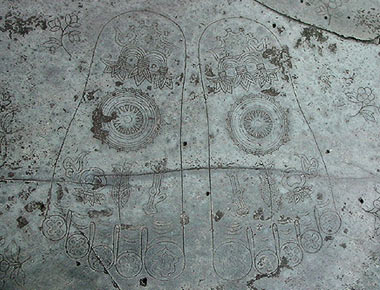| Lit.
Buddha's foot(print) stone; also written §«Õ (footprints of the Buddha).
A stone allegedly bearing the impression of the footprints of the historical Buddha,
Sakyamuni *Shaka ßÞ. In early
examples of Indian Buddhist art, Sakyamuni is not depicted in human form; instead
his presence is intimated by symbols such as the lotus, a parasol, his throne
or his footprints. The center of the soles of Sakyamuni's feet are said to have
been marked by a thousand-spoked wheel, senpukurin ççtÖ, representing
one of the 32 distinguishing marks *sanjuunisou O\ñ, of a Buddha. In
footprint stones it is usually shown surrounded by various auspicious signs such
as a vase, fish or conch shell, and the toes are also variously marked. The veneration
of the footprints of religious figures in India is not peculiar to Buddhism, being
found also in Jainism and Hinduism. In Buddhism, the footprints of the Buddha
initially appeared only in relieves depicting the Buddha's life, but later stones
bearing impressions of the Buddha's footprints became objects of worship in their
own right, and their cult is found in all Buddhist lands. The oldest extant bussokuseki
in Japan is dated 753 and preserved at Yakushiji òt in Nara, said to be a reproduction
in stone of a tracing originating from China and which in turn reproduced a model
that had been brought from India. Next to it stands a slab inscribed with a 21-verse
"poem of the Buddha's footprint stone"Bussokuseki-no-uta §«ÎÌÌ. This
footprint stone is one of the earliest examples of artistically worked stone surviving
in Japan, while the poem-style represents one of the earliest records of the Japanese
language. Footprint stones, often imitations of that at Yakushiji, either can
be placed horizontally on the ground or erected vertically in the manner of a
stele. These have been produced continuously in Japan until recent times and may
be seen at temples throughout the country. Other early examples include the bussokuseki
at Okadera ª in Nara, Shitennouji lV¤ in Osaka, Hounenin @R@ in Kyoto, Zoujouji
ã in Tokyo and Zenkouji Põ in Nagano prefecture. |



